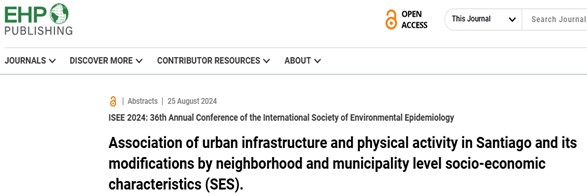Marianela Castillo Riquelme, Goro Yamada, Mariana Lazo, Steven Melly, Ricardo Hurtubia, Olga Lucia Sarmiento, Paulina Pino, Pablo Ruiz Rudolph and Ana Diez Roux
Abstract
The study aims to investigate the association between i) neighborhood-level green areas and individual-level leisure-time physical activity (PA), and between ii) neighborhood-level active travel conditions and individual-level active transportation (walking or cycling to destinations); in adults living in Greater Santiago. To further investigate how municipality or neighborhood SES influence these associations.[¤]METHOD[|]Exposures were expressed as summary indexes for green areas and active travel as well as by the single variables included in the indexes. As outcomes we used survey data georeferenced at neighborhood-level by the SALURBAL project. We included 1434 individuals (aged 15-97) living in 278 neighborhoods (34 municipalities) of Santiago, who responded the Global Physical Activity Questionnaire (GPAQ) in the national health surveys 2010 and 2017. Poisson multilevel regression analyses with robust variance were used for each physical activity type, to estimate relative risks (RR) for the binary outcome: fulfillment of WHO PA goal (150-300 minutes/week).[¤]RESULTS[|]In the sample, 20.6% and 46.2% individuals reached the PA goal with leisure-time PA and active transportation, respectively. Leisure-time PA was associated with the Green Areas Index (RR= 1.26 per 1SD increase; 95%CI 1.03-1.54; p-value=0.03) after adjusting by individual characteristics (gender, age, and educational levels), survey year and context variables (safety index and SES). Active transportation PA was not associated to the Active Travel Index. When using single variables NDVI (RR=1.12 per 1SD increase; 1.00-1.25; p-value=0.04) and public green areas per capita (RR=1.09 per 1SD increase; 1.02-1.16; p-value=004) were associated to Leisure-time PA; and population density was associated to transportation PA (RR=1.09 per 1SD increase, 1.03-1.15, p-value=0.01). We did not detect effect modification by contextual SES.[¤]CONCLUSIONS[|]These results suggest that green areas are likely to increase leisure-time PA, while good walking/cycling conditions do not influence active transportation in Greater Santiago. Further research is needed to better understand mobility patterns.
